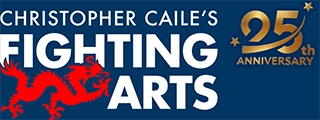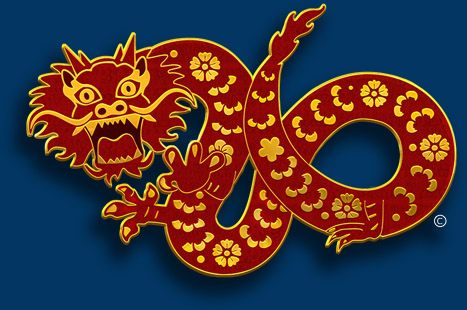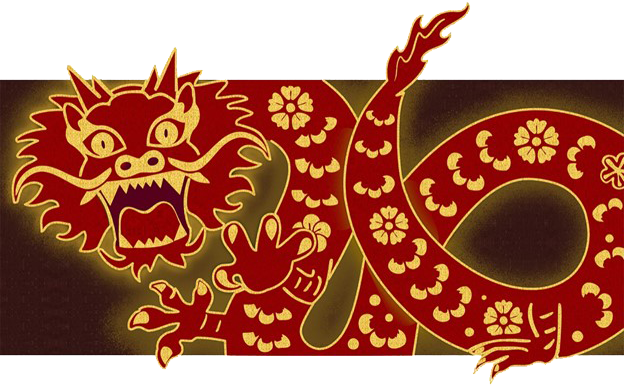A New Scary Germ
MRSA: Recognition and Prevention, Part 2
By Christopher Caile
Editor's Note: This is the second of a two part series on MRSA. Part 1 introduced the subject and its dangers. Part 2 discusses the recognition and prevention of MRSA — what to look for, how it spreads and how to protect yourself.
MRSA, introduced in Part 1 of this series, should not be taken lightly. One reader e-mailed me and said, "MRSA is nothing to ignore. I am a staff nurse in … the busiest veterans hospital in the United States. MRSA is one of our most serious in-house problems. The number of people walking around colonized with this potentially lethal bug is unbelievable."
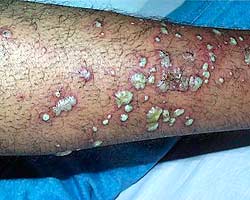
A staph infection of the leg. MRSA infections can cause rashes or boils that can leak pus or have drainage. Do not try to lance or pop it yourself. Instead seek help from you physician such as your family medicine physician, or a surgeon for best results.
Staph bacteria, including MRSA, can cause skin infections that may look like a pimple or boil and can be red, swollen, painful, or have pus or other drainage. More serious infections may cause pneumonia, bloodstream infections, or surgical wound infections.
We carry the germs from our own noses and have staph and often MRSA on our skin. And once you're colonized, it's almost impossible to eradicate. But, this is not dangerous in itself. We carry around a virtual rain forest of bacteria, viruses, fungus and contaminates mixed with body waxes and oils around on our skin. It is only when staph or MRSA breaks into the skin or into the system that real danger arises.
Martial artists should also be especially alert because their practice environment is optimal for the spread of MRSA. This includes practitioners of judo, karate, taekwondo, kung fu, mixed martial arts, even wrestlers. In fact the danger to martial artists from MRSA might be even greater than from the physical dangers from the art they practice.
How MRSA Is Spread
MRSA is almost always spread by direct physical contact – by contact with those infected (even from those having bacteria on their skin) – not through the air. Thus skin-to-skin contact (in wrestling, judo, jujutsu, aikido, kung fu and karate, etc.) can be a method of contacting the bug.
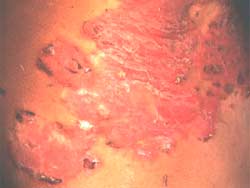 |
A staph or MRSA break out under the arm. |
MRSA can be spread indirectly too, by touching objects, clothing, surfaces or equipment that is contaminated with the bacteria. This can include shared towels, razors, uniforms, protective equipment, shared sporting equipment such as weight lifting machines, or mats.
The bacteria can live on various surfaces, such as up to 72 hours on stainless steel surfaces at room temperature. It also thrives in warm, moist environments such as towels, exercise clothes, uniforms, practice mats or equipment.
This is why schools, hospitals, prisons and other institutions across the nation have been actively cleansing and disinfecting their facilities.
You are especially vulnerable if your immune system is damaged or low due to illness or surgery.
A New York Internist noted that those with chronic skin conditions such as eczema, are also especially vulnerable since their skin condition offers ready access to infection. He also noted that today people use razors on their chests, head, arms or legs, even their genitals area. "Just a little nick in the skin can provide an opening for infection," he said.
"I see patients all the time," say Dr. Sandra Sattin, a Maryland specialist in family medicine, "who think they have just a small spider bite, but more often than not it is a staph infection. Staph or the MRSA variant often gets into a hair follicle. If standard treatment doesn't work, it may be an indication of MRSA and if it isn't treated promptly it can spread."
MRSA Symptoms
The MRSA staph variant usually involves skin eruptions, such as a red or purplish boil, a red outbreak similar to a small bite, pimple, or what looks like a bumpy rash. These infections can be red, swollen. There may be warmth around the infected area and there can be pus or other drainage.. The infected area can be painful. Often there is also a fever, or chills.
These general skin symptoms may be accompanied by fever and warmth around the inflected area.
More serious infections can cause brain abscesses, destroy bone in the vertebrae and infect the valves in the heart and destroy them if not caught in time.
I knew a karate practitioner who contracted a staph infection of his vertebrae and excruciating back pain. It took nine months in a hospital on IV antibiotics to kick the infection.
MRSA Prevention
Protect yourself from infections by practicing good hygiene. An alcohol gels work better than hand washing because we usually don't thoroughly wash our hands. Spending several minutes washing including scrubbing your nails with a germicidal agent, would be best, but is not pragmatic so use a gel if possible. . Carry your own gel or ask your health club or martial arts facility to make these products available.
Also, shower after working out and wear flip flops, but showering too often can have a negative effect. Over-washing can rinse away the protective oils and waxes secreted by the skin that help create a natural barrier to infection.
Wash your uniform and towel between practices and don't share them with others – moist warm items like these can be breeding grounds. Also, regularly clean any protective or other athletic equipment.
If you see any blood, or possible body secretion on any equipment, floor or other surface be sure that it is cleaned (use protective gloves) and disinfected immediately.
Most important cover any open skin outbreak, abrasions or cut with a clean dry bandage and insist that any work out partner do so before practicing. If someone you are practicing with has a wound or skin condition that is oozing pus, it would be advisable to avoid all contact. At minimum have the condition cleansed and covered with a bandage to prevent any leakage.
If you get an abrasion, small skin cut, or a puncture, says Dr. Sattin, wash the area thoroughly and then apply a triple antibiotic ointment before applying a bandage. "A little prevention goes a long way."
Other preventative measures include avoiding the sharing of personal items such as towels, uniforms, protective equipment, or razors.
If there is exercise or training equipment that must be shared take precautions. Wipe surfaces and/or use a barrier (clothes or a towel) between your skin and the equipment used. This is especially true with striking surfaces like punching bags and makiwara (use protective mitts).
Wear protective equipment on your hands or feet if you are in a striking art. Prompt your club or organization to sanitize practice surfaces including floors and mats as often as possible.
Know the signs of MRSA and other staph infections so you can avoid infection of other students, so you can alert students of possible infection and guide them to appropriate medical specialists for diagnosis and treatment.
Staph And MRSA Treatment
If you have a suspected infection see your health care provider.
Most staph and MRSA infections are treatable with the certain antibiotics. But monitor the condition. If the medicine prescribed does not seem to be taking effect, be sure to contact your physician for follow up. When recently I had a toe infection my New York City Internist prescribed a general antibiotic but said to monitor the situation. "If it doesn't clear up in a couple of days, come back to see me," he said. "It could be something else."
Be sure to follow directions. If given an antibiotic, take all of the prescribed doses, even if the infection is getting better.
Many staph skin infections, including MRSA, however, are in part treated by draining the abscess or boil. Some may not even require antibiotics. But do not try this yourself. Drainage of skin boils or abscesses should only be done by a professional health provider.
Also, if others you live or practice with get the same infection, tell them also to contact their health care provider.
Disclaimer:
This article is written for educational purposes only and should not be taken as a definitive medical statement or definition of MRSA or staph, their dangers, symptoms, diagnoses or treatment. This article seeks only to raise the reader's awareness about the potential dangers of MRSA and staph within the martial arts environment and stimulate the reader's own research into and awareness about these potential problems.
Acknowledgment:
The photos in this article was provided by www.metrowestcleangear.com. MetroWest CleanGear offers an effective new way to clean, disinfect and deodorize athletic equipment and gear (including MRSA) processed by their cleaning facilities without damage.

About the Author Christopher Caile
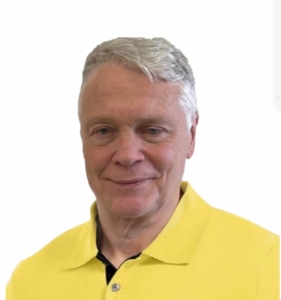
Screenshot
Christopher Caile is the Founder and Editor-In-Chief of FightingArts.com. He has been a student of the martial arts for over 65 years.
He first started in judo while in college. Then he added karate as a student of Phil Koeppel in 1959 studying Kempo and Wado-Ryu karate. He later added Shotokan Karate where he was promoted to brown belt and taught beginner classes. In 1960 while living in Finland, Caile introduced karate to that country and placed fourth in that nation's first national judo tournament.
Wanting to further his karate studies, Caile then hitch hiked from Finland to Japan traveling through Scandinavia, Europe, North Africa, the Middle East and South and Southeast Asia — living on 25 cents a day and often sleeping outside.
Arriving in Japan (1962), Caile was introduced to Mas Oyama and his fledgling full contact Kyokushinkai Karate by Donn Draeger, the famous martial artist and historian. Donn also housed him with several other senior international judo practitioners. Donn became Caile's martial arts mentor, coaching him in judo and introducing him to Shinto Muso-ryu under Takaji Shimizu.
Caile studied at Oyama's honbu dojo and also at Kenji Kurosaki's second Tokyo Kyokushinkai dojo. In his first day in class Oyama asked Caile to teach English to his chief instructor, Tadashi Nakamura. They have been friends ever since. Caile also participated in Oyama's masterwork book, "This Is Karate."
Caile left Japan with his black belt and designation as Branch Chief, the first in the US to have had extensive training in Japan directly under Oyama Sensei. As such, Oyama Sensei asked him to be his representative on visits to his US dojos to report on their status.
A little over a year later, Nakamura, Kusosaki and Akio Fujihira won an epic David vs. Goliath challenge match against Thailand's professional Muay Thai Boxers in Bangkok, Thailand, thrusting Kyolushinkai and Nakamura into national prominence.
Back in the US Caile taught Kyokushinkai karate in Peoria, Il while in college and later in Washington, DC. while in graduate school. Durimg this time Shihan Nakamura had moved to New York City to head Kyokushinkai's North American Operation.
In 1976 when Kaicho Tadashi Nakamura formed the World Seido Karate organization, Caile followed. Living then in Buffalo, NY, Caile taught Seido karate and self-defense at the State University of New York at Buffalo (SUNY Buffalo) for over 15 years where he also frequently lectured on martial arts and Zen in courses on Japanese culture.
Caile moved to New York City in 1999 to marry Jackie Veit. He is now an 8th degree black belt, Hanshi, training in Seido Karate's Westchester, NY Johshin Honzan (Spiritual Center) dojo. In Seido Caile is known for his teaching of and seminars on kata applications. He also produced a 14 segment video series on Pinan kata Bunkai currently available to Seido members.
Caile is also a long-time student and Shihan in Aikido. He studied in Buffalo, under Mike Hawley Shihan, and then under Wadokai Aikido's founder, the late Roy Suenaka (uchi deshi under Morihei Ueshiba, founder of Aikido and was Shihan under Tohei Sensei). In karate, Suenaka (8thdan) was also an in-house student of the Okinawan karate master Hohan Soken.
Having moved to New York City, Caile in 2000 founded this martial arts educational website, FightingArts.com. Twenty-five years later, in 2025, it underwent a major update and revision.
For FightingArts.com and other publications Caile wrote hundreds of articles on karate, martial arts, Japanese art, Chinese Medicine and edited a book on Zen. He also developed relationships with a cross section of leading martial arts teachers. Over the last four decades he has conducted extensive private research into karate and martial arts including private translations of the once secret Okinawan hand copied and passed on Kung Fu book, the Bubishi, as well as an early karate book by the karate master Kenwa Mabuni. He periodically returns to Japan and Okinawa to continue his studies and participate Seido karate events. In Tokyo he practiced (with Roy Suenaka Sensei) in a variety of aikido organizations with their founders – including private interviews and practices at the Aiki-kai Aikido Honbu dojo with the son and grandson of aikido's founder, Doshu (headmaster) Kisshomaru (an old uchi-deshi friend) and his son, Moriteru Ueshiba and in Iwama with Morihiro Saito. On Okinawa he studied Goju Ryu karate under Eiichi Miyazato, 10th dan founder of Naha's Jundokan, and also with Yoshitaka Taira (who later formed his own organization, who specialized in kata Bunkai. While there Caile also trained with Hohan Soken's senior student, Master Fusei Kise, 10 dan as well as with the grandson of the legendary karate master Anko Itosu.
Caile's other martial arts experience includes: Diato-ryu Aikijujitsu and Kenjitsu, kobudo, boxing, Muay Thai, MMA, Kali (empty hand, knife and bolo), study of old Okinawan Shoran-ryu & Tomari body mechanics, study of old Okinawan kata under Richard Kim, study of close quarter defense and combat, including knife and gun defenses, Kyusho Jitsu and several Chinese fighting arts including 8 Star Praying Mantis, Pak Mei (White Eyebrow), and a private family system of Kung Fu.
Caile is also a student of Zen as well as a long-term student of one branch of Traditional Chinese Medicine, Chi Kung (Qigong). As one of two senior disciples of Chi Kung master Dr. Shen (M.D., Ph.D.) Caile was certified to teach and practice. This led to Caile's founding of the The Chi Kung Healing Institute on Grand Island, NY. In Western NY, he also frequently held Chi Kung seminars, including at SUNY Buffalo and at the famous Chautauqua Institution in Chautauqua, NY. His articles on Chi Kung also appeared in the Holistic Health Journal and in several books on alternative medicine.
Caile holds a BA in International Studies from Bradley University and MA in International Relations with a specialty in South and Southeast Asia from American University in Washington, D.C. While in Buffalo, NY he also studied digital and analog electronics.
In his professional life Caile also worked in public relations and as a newspaper reporter and photographer. Earlier he worked in the field of telecommunications including Managing a Buffalo, NY sales and service branch for ITT. He then founded his own private telephone company. This was followed by creation of an electrical engineering company that designed and patented his concept for a new type of low-cost small business telephone system (which was eventually sold to Bell South). The company also did contract work for Kodak and the US space program. Simultaneously Caile designed and manufactured a unique break-apart portable pontoon boat.
Most recently Caile co-founded an internet software company. Its products include software suites with AI capability for control and management of streaming media, such as video and music, an all-in-one book publishing software product for hardcover, eBook and audio book creation and security software for buildings and government use.
For more details about Christopher Caile's martial arts, work experience and life profile, see the About section in the footer of this site.
Search for more articles by this author:
